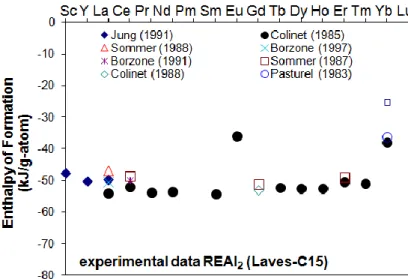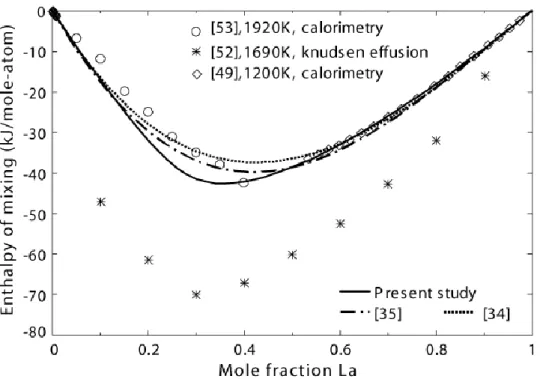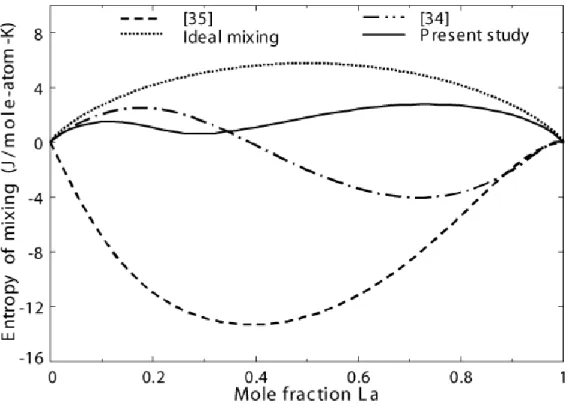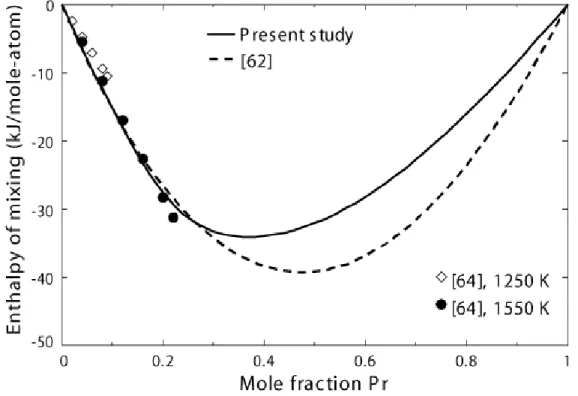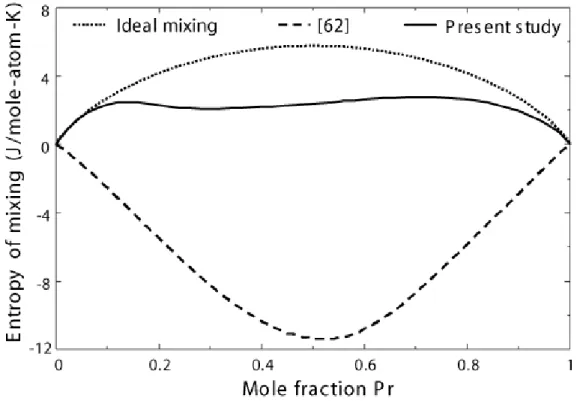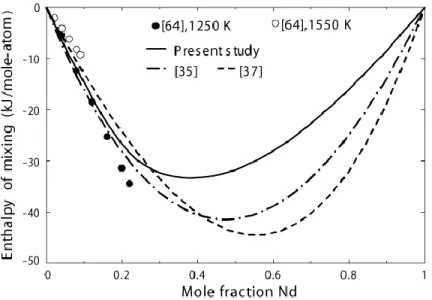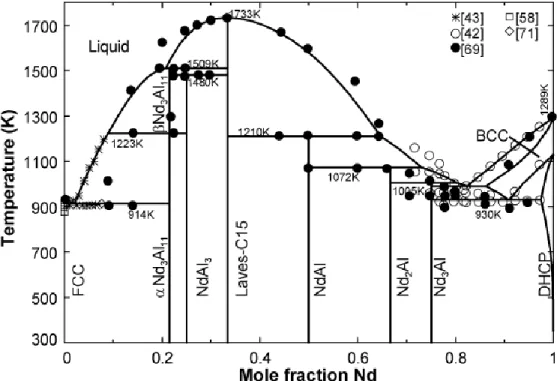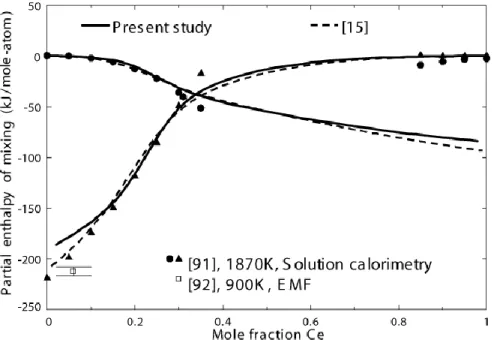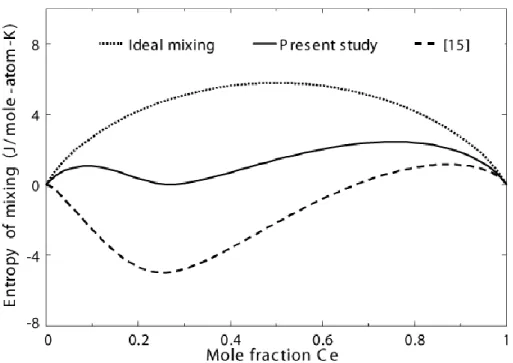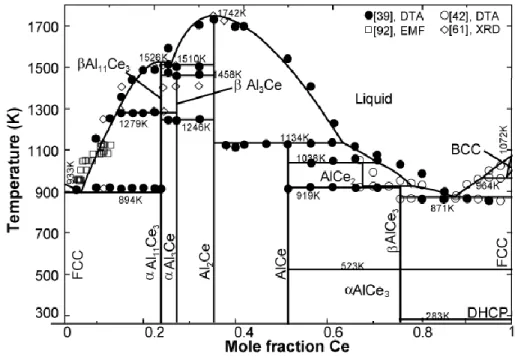UNIVERSITÉ DE MONTRÉAL
THERMODYNAMIC MODELING OF ALUMINUM-MAGNESIUM-RARE
EARTH SYSTEMS
LILING JIN
DÉPARTEMENT DE GÉNIE CHIMIQUE ÉCOLE POLYTECHNIQUE DE MONTRÉAL
THÈSE PRESENTÉE EN VUE DE L’OBTENTION DU DIPLÔME DE PHILOSOPHIAE DOCTOR
(GÉNIE MÉTALLURGIQUE) AOÛT 2012
UNIVERSITÉ DE MONTRÉAL
ÉCOLE POLYTECHNIQUE DE MONTRÉAL
Cette thèse intitulée:
THERMODYNAMIC MODELING OF ALUMINUM-MAGNESIUM-RARE EARTH SYSTEMS
présentée par : JIN Liling
en vue de l’obtention du diplôme de : Philosophiae Doctor a été dûment acceptée par le jury d’examen constitué de : M. PELTON Arthur D., Ph. D., président
M. CHARTRAND Patrice, Ph. D., membre et directeur de recherche M. JUNG In-Ho, Ph. D., membre
DEDICATION
ACKNOWLEDGEMENTS
I would like to express my deepest gratitude toward my research supervisor Prof. Patrice Chartrand, for providing me such a wonderful opportunity to deepen my scientific knowledge and for his guidance and support throughout my studies.
I would also like to thank the Center for Research in Computational Thermochemistry (CRCT) at École Polytechnique de Montréal, where this project has been completed.
I am also grateful to Prof. Mamoun Medraj, Dr. Dmytro Kevorkov, Mr. Mazen Samara, Mr. Tian Wang and Mr. Yi-Nan Zhang from Concordia Universtiy, without whom the diffusion couple and key experiments could not have been done.
I would like to give my special thanks to Prof. Ping Wu and Dr. Kewu Bai at Institute of High Performance Computing (IHPC), Singapore for their training of the First-Principles calculations. I am indebted to Prof. Arthur D. Pelton, Prof. Christopher Bale, and Dr. Youn-bae Kang for their helpful advice and discussions. I am very grateful to Dr. Aimen Gheribi for the discussion and support on First-Principles and Miedema’s model. I would like to thank Dr. Christian Robelin for french translation of the abstract.
I would like to show my appreciation to Prof. In-Ho Jung from McGill University, who provided neodymium metal for my experiments. I would like to thank Dr. Lang Shi from McGill University for his help with electron probe microanalysis (EPMA) experiments.
I would like to thank all the members of CRCT, Dr. Christian Robelin, Dr. Aimen Gheribi, Dr. Jacques Melançon, Mme Catherine Boucher, Mme Éve Belisle, Dr. Wan-Yi Kim, Mr. Adarsh Shuklar, Dr. Guillaume Lambotte, Mr. Zhi-jun Zhu, Mr. Jian Wang, etc, for their friendship and kindness. I would like to express my deepest gratitude to Luc for his support and encouragement. Last but not least, financial support from General Motors of Canada Ltd. and the Natural Sciences, Engineering and Research Council of Canada through the CRD grant program, REGAL and FQRNT are gratefully acknowledged.
RÉSUMÉ
Le magnésium et ses alliages sont les matériaux métalliques structuraux les plus légers et, de ce fait, jouent un rôle croissant dans les domaines de l’automobile, de l’aérospatial et de l’électronique. Bien que le magnésium puisse être recyclé aisément et ait une conductivité thermique élevée et de bonnes propriétés de protection électromagnétique, il présente des inconvénients : une force insuffisante, une faible résistance à la corrosion et au fluage,… L’utilisation d’alliages de magnésium est l’une des méthodes fréquemment utilisées pour améliorer les propriétés du magnésium. L’ajout de terres rares (RE : « Rare Earth ») à des alliages de magnésium peut améliorer leur force et leur résistance au fluage à température élevée en formant des précipités stables à base de Mg (REyMgx), Al (REyAlx) ou Zn (REyZnx).
Parallèlement au développement d’alliages de Mg, les alliages Al–RE (aluminium-terre rare) sont d’intérêt en science des matériaux dans le cadre du développement d’alliages légers. Les terres rares sont des éléments d’alliage d’importance croissante pour les alliages d’aluminium à cause de leur capacité à améliorer les propriétés à haute température et les caractéristiques de moulage. De plus, les alliages Al–RE rapidement solidifiés offrent aussi la possibilité d’obtenir un meilleur comportement en corrosion.
Les méthodes calculatoires sont des outils importants et puissants pour la sélection et l’élaboration de nouveaux alliages de magnésium. Elles aident à comprendre le comportement des matériaux et réduisent significativement la quantité de travail expérimental requise. De plus, les terres rares pures sont très coûteuses.
Jusqu’à présent, il n’existait aucun diagramme de phases pour les systèmes Mg-Al-Mischmetal optimisé à l’aide du modèle quasichimique (prenant en compte l’ordre à courte distance) pour la phase liquide, à l’exception de quelques optimisations récentes (Al–Ce, Al–Y, Al–Sc) effectuées par le Dr. Youn-Bae Kang au CRCT de l’Ecole Polytechnique de Montréal. De plus, certains systèmes (Al–Mg–Pr, Al–Mg–Nd, Al–Mg–Tb, Al–La–Nd, Al–Pr–Nd, Al–La–Pr, Al–Ce–La et Al–Ce–Pr) n’avaient pas encore été optimisés thermodynamiquement.
L’objectif principal de cette thèse est de développer une banque de données thermodynamiques pour le système Al–Mg–La–Ce–Pr–Nd–Sm–Gd–Tb–Dy–Ho–Er. Ainsi, des modèles
thermodynamiques pour le liquide, les solutions solides et les composés stœchiométriques ont été proposés; les diagrammes de phases et les propriétés thermodynamiques des systèmes binaires Al–RE, Mg–RE et RE'–RE", ainsi que des systèmes ternaires Mg–Al–RE et Al–RE'–RE" ont été optimisés à l’aide des données expérimentales et / ou théoriques. Le second objectif consiste à faire des expériences clés dans la région riche en magnésium afin de vérifier les équilibres des phases, car cela est très important pour la conception de nouveau alliage à base de magnésium. L’étude expérimentale a été effectuée pour les systèmes ternaires Al–Mg–La, Al–Mg–Ce, Al– Mg–Pr et Al–Mg–Nd afin d'obtenir les phases en équilibres ainsi que les informations concernant les solubilités des solutions solides. Le troisième objectif de la recherche consiste à développer des méthodes originales pour estimer les données thermodynamiques absentes de la littérature scientifique pour les phases contenant des terres rares.
Nous avons tout d’abord optimisé les systèmes binaires Al–RE (RE= La, Ce, Pr, Nd, Sm, Gd, Tb, Dy, Ho, Er) à partir d’une revue de la littérature pour les solides (composés intermétalliques, structures cristallographiques, températures de fusion, chaleurs de formation, températures de transformation,…), pour les propriétés du liquide (enthalpie de mélange intégrale, enthalpie de mélange partielle, activités des composants, capacités calorifiques, solubilités à l’état solide,…) et pour les données expérimentales de diagrammes de phases. Une approche systématique a été adoptée au cours des optimisations thermodynamiques. Puisque les terres rares sont chimiquement proches, une comparaison avec les terres rares voisines et une analyse systématique de la température de fusion des composés a facilité l’optimisation du système Al– Tb pour lequel peu de données expérimentales étaient disponibles.
Deuxièmement, pour les systèmes Mg–RE pour lesquels les données expérimentales étaient rares ou contradictoires, des calculs de premier principe ont été utilisés pour évaluer l’enthalpie de formation de certains composés ainsi que l’enthalpie de mélange pour les phases FCC et HCP à l’aide de la technique “supercell”. En parallèle, des estimations ont été faites à l’aide du modèle semi-empirique de Miedema puis ont été comparées aux calculs de premier principe. Il a été suggéré que le modèle semi-empirique de Miedema peut fournir un bon estimé initial pour l’enthalpie de formation des composés et l’enthalpie de mélange de solutions sans un coût élevé
en calculs. Ainsi, le modèle de Miedema a été utilisé pour estimer l’enthalpie de formation des composés ternaires et des phases métastables dans les systèmes ternaires Mg–Al–RE.
Troisièmement, en ce qui concerne les systèmes ternaires Mg–Al–RE, leurs propriétés thermodynamiques et leurs équilibres de phase ont été moins étudiées comparativement aux autres systèmes métalliques. Les évaluations et optimisations thermodynamiques des systèmes Al–Mg–RE (RE= La, Ce, Pr, Nd, et Sm) ont été effectuées systématiquement sur la base de l’information disponible dans la littérature et de nos résultats expérimentaux. Dans ce travail, des expériences-clés ont été réalisées pour les systèmes Mg–Al–La, Mg–Al–Ce, Mg–Al–Pr, et Mg– Al–Nd pour vérifier les équilibres de phases dans le coin riche en Mg et les solubilités à l’état solide. Les estimations à l’aide du modèle de Miedema de l’enthalpie de formation pour les composés ternaires ont été utilisées pour les optimisations thermodynamiques de tous les systèmes Mg–Al–terre rare. Dans les systèmes Mg–Al–Gd (Dy, Ho), des compromis ont été faits entre les données expérimentales (température du liquidus) et les optimisations en considérant la fiabilité limitée des expériences à haute température (1200 K et plus). Nous n’avons pas jugé nécessaire l’utilisation de nombreux paramètres ternaires en excès pour le liquide pour bien reproduire les données expérimentales. Le système Mg–Al–Tb a été estimé en supposant des similarités avec les systèmes Mg–Al–Gd (Dy), et les résultats correspondants ont été présentés pour la première fois dans la présente étude. Une technique d’interpolation de type Kohler a été utilisée, considérant le fait que les enthalpies de mélange des liquides Al–Mg, Al–RE et Mg–RE sont très différentes les unes des autres.
Quatrièmement, pour les systèmes Al–RE'–RE", les systèmes binaires RE'–RE" (La–Ce, La–Pr, La–Nd, Ce–Pr, Ce–Nd, Pr–Nd) ont été optimisés à partir de l’information expérimentale disponible. A l’exception des systèmes La–Nd et Ce–Pr, aucun paramètre en excès n’a été utilisé pour le liquide. Des données expérimentales ne sont disponibles que pour le système Al–Ce–Nd. Les autres systèmes Al–RE'–RE” ont été optimisés en supposant des propriétés thermodynamiques similaires à celles du système Al–Ce–Nd.
La banque de données thermodynamiques pour les systèmes Mg–Al–RE fournira une ligne directrice claire pour la sélection et l’élaboration d’alliages de Mg et de Al; ce qui permettra d’éviter des expériences à long-terme improductives portant sur des alliages ayant moins de potentiel pour des applications pratiques.
ABSTRACT
As the current lightest structural metallic material, magnesium and its alloys play an increasingly important role in automotive, aerospace and electronic consumer products. Although magnesium has excellent recyclability, high thermal conductivity, good electromagnetic shielding characteristics and so on, it suffers from its shortcomings: insufficient strength, poor corrosion and low creep resistance, etc. Alloying magnesium is one of the frequently used methods to improve its properties. Adding Rare Earth (RE) metals to magnesium alloys can improve their strength and creep resistance at elevated temperatures by forming stable precipitates with Mg, for example, (REyMgx), Al (REyAlx) or Zn (REyZnx).
Parallel to Mg alloys development, Al–RE (aluminum – rare earths) alloys have been of interest to materials scientists who want to develop light weight alloys. Rare earths have an increasing importance as alloying elements in aluminum alloys because of their ability to enhance the high temperature properties and casting characteristics. Moreover, rapidly solidified Al–RE alloys also offer the possibility of obtaining better corrosion behavior.
Computational methods are important and powerful tools in the selection and design of new magnesium alloys. These methods help our understanding of materials behavior, while they significantly reduce extensive and time-consuming experimental work. Furthermore, pure rare earth metals are expensive.
Up to the present, few phase diagrams for Mg–Al–Mischmetal systems have been optimized using the quasichemical model (which takes into account short-range ordering) for the liquid phase except some recent optimizations (Al–Ce, Al–Y, and Al–Sc) by Dr. Youn-Bae Kang of CRCT at École Polytechnique de Montréal. Furthermore, some systems (Al–Mg–Pr, Al–Mg–Nd, Al–Mg–Tb, Al–La–Nd, Al–Pr–Nd, Al–La–Pr, Al–Ce–La, and Al–Ce–Pr) have not yet been thermodynamically optimized.
The main objective of this thesis is to build a thermodynamic database for Al–Mg–La–Ce–Pr– Nd–Sm–Gd–Tb–Dy–Ho–Er systems. To this end, thermodynamic models of liquid and solid solutions and stoichiometric compounds have been proposed; phase diagrams and thermodynamic properties of binary Al–RE, Mg–RE, RE'–RE" systems, ternary Mg–Al–RE and Al– RE'– RE" systems have been optimized based on experimental and/or theoretical data. The secondary objective of this research is to do key experiments in the magnesium-rich corners of ternary systems to check phase equilibrium, since this is very important for Mg alloy design. Key experimental investigations have been performed for the Al–Mg–La, Al–Mg–Ce, Al–Mg–Pr and Al–Mg–Nd ternary systems in order to obtain phase equilibria and solid solubilities information. The third objective in this work is to find or develop proper methods for estimating the missing thermodynamic data for the binary and ternary phases which include rare earth elements.
First, Al–RE (RE= La, Ce, Pr, Nd, Sm, Gd, Tb, Dy, Ho, Er) binary systems were optimized, based on literature review for the solids (intermetallic compounds, their crystal structures, melting points, enthalpy of formation, transformation temperature, etc), liquid properties (integral enthalpy of mixing, partial enthalpy of mixing, activities of the components, heat capacities, solid solubility and so on) and experimental phase diagram data. A systematic approach has been used in the course of thermodynamic optimizations. Since rare earths are chemically similar, comparision with neighboring rare earth elements and systematic analysis of melting point of compounds helped in the optimization of the Al–Tb system, in which few experimental data are available.
Second, for the Mg–RE systems in which the experimental data were scarce or contradictory, First-Principles were employed to calculate the enthalpy of formation of certain compounds and enthalpy of mixing for the FCC and HCP phases using the supercell technique. Meantime, estimations from the semi-empirical Miedema model were made and compared to First-Principles calculations. It was suggested that the semi-empirical Miedema model can provide a good initial guess for the enthalpy of formation of compounds and the enthalpy of mixing for solutions for thermodynamic optimizations, without high computing cost. Therefore, the Miedema model was
used to estimate the enthalpy of formation of the ternary compounds and metastable phases in Mg–Al–RE ternary systems.
Third, as for Mg–Al–RE ternary systems, less research has been done on the thermodynamic properties and phase equilibria of these systems compared to other metallic systems. Thermodynamic evaluations and optimizations of the Al–Mg–RE (RE= La, Ce, Pr, Nd, Sm) systems have been systematically carried out on the basis of literature information and our experimental results. In this work, key experiments were performed for the Mg–Al–La, Mg–Al– Ce, Mg–Al–Pr, and Mg–Al–Nd systems to check phase equilibria in the Mg-rich corners and solid solubilities. The estimations of enthalpy of formation for the ternary compounds from Miedema model were used for thermodynamic optimizations of all the Mg–Al–rare earth systems. In the Mg–Al–Gd (Dy, Ho) systems, careful weighting was made between the experimental data (liquidus temperature) and optimization results, considering the restricted accuracy of experimental results at high temperatures (1200 K and more). It was judged unnecessary to use many excess ternary parameters for the liquid to fit satisfactorily the experimental data. The Mg–Al–Tb system was estimated by assuming similarities to the Mg–Al– Gd (Dy) systems and is presented for the first time in the present study. The Kohler-type interpolation method was used, seeing that the enthalpies of mixing of the liquid in the Al–Mg, Al–RE, and Mg–RE systems differ significantly.
Fourth, RE'–RE" (La–Ce, La–Pr, La–Nd, Ce–Pr, Ce–Nd, Pr–Nd) binary systems were optimized based on the available experimental information. Except for the La–Nd and Ce–Pr systems, no excess parameters were used for the liquid. For the Al–RE'–RE" systems, experimental data are available only for the Al–Ce–Nd system. Other Al– RE'–RE” systems were optimized assuming thermodynamic properties similar to those of the Al–Ce–Nd system.
The thermodynamic database of the Mg–Al–RE systems will provide clear guidelines for Mg and Al alloy selection and design, thereby avoiding unproductive long-term experiments with alloys which have less potential for practical applications.
CONDENSÉ EN FRANÇAIS
Les alliages à base de magnésium sont parmi les plus légers matériaux structuraux et dont les applications commerciales sont importantes (industrie automobile et aérospatiale par exemple). L’addition d’éléments chimiques comme les terres rares (RE) dans les alliages de magnésium pourrait améliorer certaines de leurs propriétés physiques et mécaniques. Les terres “rares” ne sont pas rares. Par exemple, Ce est plus abondant dans la croûte terrestre que Sn, tandis que Y et Nd sont plus abondants que Pb. Cependant, les terres rares sont généralement présentes à de très faibles concentrations et coexistent toujours avec d’autres terres rares puisque ces éléments sont chimiquement proches. Suite à leur forte affinité mutuelle, les terres rares sont extrêmement difficiles à séparer l’une de l’autre. On distingue quinze éléments : La, Ce, Pr, Nd, Sm, Eu, Gd, Dy, Ho, Er, Tm, Yb et Lu. Pour des raisons pratiques, les terres rares incluent souvent le scandium (Sc) et l’yttrium (Y) puisque ces deux éléments ont des caractéristiques similaires à celles des lanthanides. Les terres rares sont souvent divisées en deux sous-groupes : les éléments légers (de La à Sm) et les éléments lourds (de Gd à Lu).
La prédiction des propriétés thermodynamiques et des équilibres de phases pour les systèmes Mg–Al–RE une étape très importante lors du développement de nouveaux alliages à base de magnésium. Dans un alliage multi-constitué et multiphasique, il est très utile de développer des banques de données thermodynamiques, contenant les informations relative à chaque phase du système, afin de mieux comprendre et prédire les propriétés thermodynamiques, et les relations de phases pour des systèmes plus complexes.
L’objectif principal de cette thèse consiste en la modélisation des propriétés thermodynamiques et des équilibres de phase des systèmes Mg–Al–RE. Le second objectif consiste à faire des expériences clés dans la région riche en magnésium afin de vérifier les équilibres des phases, car cela est très important pour la conception de nouveaux alliages à base de magnésium. L’étude expérimentale a été effectuée pour les systèmes ternaires Al–Mg–La, Al–Mg–Ce, Al–Mg–Pr et Al–Mg–Nd afin d'obtenir les phases en équilibres ainsi que les informations concernant les solubilités des solutions solides. Des expériences de type « couples de diffusion » ont également été effectuées pour vérifier les phases en équilibres dans les systèmes ternaires étudiés. Le troisième objectif de la recherche consiste à développer des méthodes originales pour estimer les données thermodynamiques absentes de la littérature scientifique pour les phases contenant des
terres rares. Ces données sont par exemple les entropies et les enthalpies de formation des composés stœchiométriques binaires. La première approche fut la systématisation des propriétés thermodynamiques (enthalpies de mélange) en fonction des numéros atomiques des terres rares formant le mischmétal. Par la suite, des modèles basés sur des principes physiques tels que les calculs ab initio ou le modèle de Miedema ont été utilisés pour estimer les enthalpies de formation des composés stœchiométriques binaires, ainsi que les enthalpies de mélange des solutions solides : (Al)-FCC et (Mg)-HCP.
Une des hypothèses de la modélisation thermodynamique de ce travail est que le modèle quasichimique modifié avec l’approximation des paires, où la fonction d’enthalpie libre rend compte de l’ordre à courte distance, peut reproduire le comportement d’une solution liquide avec un fort ordonnancement. La présente modélisation est réalisée sous trois contraintes: i) les énergies de Gibsb de référence (g0) d'éléments purs doivent être ceux de la base de données SGTE (ou de publications antérieurs de notre groupe de recherche pour quelques terres rares), et les g0 des composés de références (tel que Al2Mg, Mg2Mg, Mg2Al, Al2Al dans la phase de
Laves_C15) doivent être ceux de la banque de données FTlite existante. ii) la base de données thermodynamique a été construite en se basant sur celle dite des « éléments légers » (FTlite) déjà existante et disponible dans le logiciel FactSage. iii) les nombres de coordination des liquides métalliques purs (Al, Mg, RE) doivent être identiques à ceux de la banque de données existante (FTLite).
La présente étude fait partie d’un grand projet de recherche au sein du CRCT (Centre de recherche en Calcul Thermochimique de l’École Polytechnique de Montréal) afin de développer une nouvelle banque de données thermodynamiques d’alliages à base de magnésium en incluant des éléments d’addition susceptibles d’être bénéfiques pour diverses propriétés physiques, mécaniques et de moulage.
La modélisation des propriétés thermodynamiques des alliages de type : Mg–Al–RE a été effectuée en respectant les étapes suivantes :
1- Revue de la littérature en vue de l’obtention des données expérimentales des équilibres de phases et des propriétés thermodynamiques. Pour l'optimisation thermodynamique d'un diagramme de phase, la première étape consiste à recueillir et à classer toutes les données expérimentales pour le système d'intérêt. Ces données sont : les enthalpies intégrales de
mélange, les enthalpies partielles de mélange, les activités des composants, les capacités calorifiques, la solubilité des constituants dans les solutions solides, les structures cristallines ainsi que les points de fusion des composés intermétalliques, les enthalpies de formation et les températures de transitions de phases. Parfois, des données utiles peuvent être disponibles uniquement pour des systèmes d'ordre supérieur (systèmes ternaires, quaternaires, etc...).
2- Évaluer les données expérimentales. L'évaluation critique des données expérimentales avant de procéder à l'optimisation thermodynamique est nécessaire pour éliminer les données contradictoires ou jugées peu fiables. Cela nécessite une connaissance des différentes méthodes expérimentale. L’évaluation critique des données expérimentales peut également être basée sur diverses règles (Gibbs-Konovalov pour les phases intermédiaires, relation de Van't Hoff entre les pentes du liquidus et du solidus, des valeurs empirique pour l’entropie et l’enthalpie, etc.).
3- Développer des techniques d'analyse systématiques. Il est connu que, dans la famille des terres rares, les propriétés thermodynamiques, voire les équilibres de phase, changent selon un modèle systématique, et on observe que certaines propriétés de ces éléments ou des composés qui y sont liés sont représentées par des lois empiriques. L’enthalpie de formation, la température de fusion des composés, l'enthalpie et l’entropie de fusion, etc, seront systématiquement analysées en fonction du numéro atomique, des rayons atomiques, ou de l’électronégativité de la terre rare afin de trouver une tendance acceptable. Par la suite, les quelques données manquantes peuvent être interpolées ou extrapolées.
4- Évaluer les données absentes de la littérature par des calculs ab initio ou des estimations par des modèles semi-empiriques tels que le modèle de Miedema. Les calculs ab initio et les estimations via le modèle Miedema ont été utilisées pour estimer les enthalpies de formation des phases binaires, l'enthalpie de mélange des phases (Al)-FCC et (Mg)-HCP. Ces calculs théoriques sont très importants parce que certaines des données enthalpiques sont rares et difficiles à mesurer. Dans le cadre de ce projet, les calculs ab initio on été effectués lors d’un stage en collaboration avec l'Institut de Calcul Haute Performance (IHPC, Prof. Ping Wu) à Singapour (février-mai 2009). Les enthalpies de formation pour
certaines phases métastables et certaines phases stœchiométriques ternaires sont calculées par le modèle semi-empirique de Miedema.
5- Choix du modèle thermodynamique le plus approprié pour les diverses phases. Pour construire une banque de données précise et fiable pour un système multi-constitué, il est crucial de choisir le modèle thermodynamique pour la phase basé sur sa structure cristalline (le nombre et le type de sous-réseaux..) afin de permettre la prédiction pour des systèmes à multi-constitué à partir des paramètres du modèle des sous-systèmes.
6- Optimiser les paramètres du modèle des systèmes binaires et ternaires. Après l'évaluation des données expérimentales et les choix des modèles thermodynamiques appropriés les paramètres du modèle sont optimisés afin de reproduire toutes les données expérimentales fiables. Dans la présente étude, le logiciel de calcul thermodynamique FactsageTM (Bale, et al., 2002) a été utilisé. Les diagrammes de phases ternaires correspondants peuvent être optimisés en utilisant des modèles géométriques appropriés et les fonctions thermodynamique des sous-systèmes binaires. Dans certain cas, un terme d’excès de l’enthalpie libre (mineur en général) est ajouté afin de raffiner les paramètres. En général, les données expérimentales ternaires disponibles pour le liquide ont été reproduites de façon satisfaisante à l’aide des paramètres binaires seulement.
Dans le Chapitre 2, nous décrivons brièvement la méthode CALPHAD (Calculation of Phase Diagrams), la minimisation de l’énergie libre de Gibbs d’un système, et les différents modèles thermodynamiques utilisés dans ce travail. Pour décrire la propriété de la phase liquide, le Modèle Quasichimique Modifié (MQM) développé à l’École Polytechnique de Montréal a été utilisé. Ce modèle thermodynamique de solution est physiquement réaliste en considérant l’ordre à courte distance.
Dans le Chapitre 3, nous décrivons brièvement la méthodologie adoptée dans cette thèse : La méthode ab initio, le modèle semi-empirique (Miedema model), les méthodes expérimental et systématique ainsi que la technique d’estimation des enthalpies et entropies de formation des composes stœchiométriques. La méthode ab initio qui est un outil indispensable aujourd’hui est utilisé pour calculer des enthalpies de formation dans le système Mg–RE, où il n'y a pas ou peu
de données expérimentales rapportées dans la littérature ou bien dans certains cas les données expérimentales sont très différentes. De plus, le modèle semi-empirique (Miedema model) est utilisé pour estimer les enthalpies de formation et enthalpies de mélange dans les solutions solides (Al)-FCC et (Mg)-HCP.
Dans le Chapitre 4, la façon d’organiser les articles dans cette thèse est décrite. A l’aide des modèles thermodynamiques décrits dans le Chapitre 2 et les données expérimentales publié dans la littérature ou calculé par les méthodes décrites dans le Chapitre 3, nous avons modélisé les phases solides et liquides de 21 systèmes binaires (Al–La, Al–Ce, Al–Pr, Al–Nd, Al–Sm, Al–Gd, Al–Tb, Al–Dy, Al–Ho, Al–Er, Mg–La, Mg–Ce, Mg–Pr, Mg–Nd, Mg–Sm, La–Ce, La–Pr, La–Nd, Ce–Pr, Ce–Nd, Pr–Nd), et 16 systèmes ternaires (Al–Mg–La, Al–Mg–Ce, Al–Mg–Pr, Al–Mg– Nd, Al–Mg–Sm, Al–Mg–Gd, Al–Mg–Tb, Al–Mg–Dy, Al–Mg–Ho, Al–Mg–Er, Al–La–Ce, Al– La–Pr, Al–La–Nd, Al–Ce–Pr, Al–Ce–Nd, Al–Pr–Nd). Les résultats sont présentés dans les Chapitre 5 à 9 et l’annexe III. Les propriétés thermodynamiques des systèmes multi-constitués peuvent donc être estimées et prédites avec une bonne précision selon des paramètres des modèles obtenus pour les systèmes binaires et ternaires.
Les trois articles des Chapitres 5 à 7 sont publiés dans le journal de Calphad. Le premier (Chapitre 5) présente les optimisations thermodynamiques des systèmes : Al–La, Al–Ce, Al–Pr, Al–Nd, et Al–Sm de la façon systématique et doit être lus en relation avec l’article du Chapître 6 qui y fait suite. La phase liquide de la solution Al–RE a été modélisée à l’aide du Modèle Quasichimique Modifié avec l’approximation de paires. Les solutions solides quand à elles ont été modélisées à l’aide du modèle des sous-réseaux ou « Compound Energy Formalism ». La procédure d'optimisation a été orientée en mettant l’accent sur les tendances observées dans les propriétés thermodynamiques des systèmes Al–RE. Il est montré que le modèle Quasichemique Modifié utilisé pour les alliages liquides nous permet d'obtenir des entropies de mélange qui sont plus fiables que celles basées sur un modèle statistique de mélange aléatoire (Bragg - Williams) qui ne prend pas des en compte l’ordonnancement à courte distance.
Le deuxième article (Chapitre 6) présente, en suite de l’article précédent, les optimisations thermodynamiques des systèmes Al–Gd, Al–Tb, Al–Dy, Al–Ho, et Al–Er. Une technique
systématique (proposé par Gschneidner) a été utilisée pour estimer le diagramme de phase Al–Tb en raison du manque de données expérimentales. Les valeurs de (HT-H273K) pour le composé
stœchiométrique Al2Er ont été reportées dans la littérature, en considérant ces données, la
capacité calorifique d’excès (ΔCp) de cette phase a pu être estimée. La différence de capacité
calorifique (ΔCp) des autres composés intermétalliques ont été interpolées linéairement entre Al
pur et Al2Er ou Er pur et Al2Er. Les paramètres optimisés du modèle pour toutes les phases
reproduise de manière très satisfaisante toutes les données expérimentales fiables.
Le troisième article (Chapitre 7) présente les optimisations thermodynamiques des systèmes Mg– La, Mg–Ce, Mg–Pr, Mg–Nd, et Mg–Sm. La solubilité des RE dans la solution solide Mg – HCP a été soigneusement évalué en considérant la tendance linéaire (ln xRE versus 1/T) selon
l’équation et calcul d’enthalpie de formation des composés intermétalliques (Mg12La, Mg12Ce, Mg12Pr, Mg41Nd5, Mg41Sm5) a été évalué par le Modèle
Miedema et les simulations ab initio. Les résultats de ces deux approches sont comparables. Les optimisations thermodynamiques des systèmes Mg–La, Mg–Ce, Mg–Pr, Mg–Nd, et Mg–Nd été effectuées de façon systématique. Les paramètres optimisés du modèle pour toutes les phases reproduise de manière très satisfaisante toutes les données expérimentales fiables.
Le quatrième article (Chapitre 8) présente les optimisations thermodynamiques des systèmes Mg–Al–La, Mg–Al–Ce, Mg–Al–Pr, Mg–Al–Nd, et Mg–Al–Sm avec les donnée expérimentales obtenues au cours de cette étude ainsi que les donnée expérimentales disponibles dans la littérature. Dix expériences ont été réalisées afin de vérifier les équilibres de phases dans les systèmes ternaires, spécialement dans les régions riches en Mg. Les solubilités dans les composés LaMg12, CeMg12 et PrMg12 et Nd5Mg41 sont vérifiées. Deux expériences de type « couples de
diffusion » ont été aussi effectuées. Les paramètres optimisés du modèle pour toutes les phases sont en accord avec nos données expérimentales et les données dans issues de la littérature.
Le Chapitre 9 présente les optimisations thermodynamiques des systèmes ternaires Mg–Al–Gd, Mg–Al–Tb, Mg–Al–Dy, Mg–Al–Ho, et Mg–Al–Er. Pour la première fois, le système Mg–Al–Tb
0
lnxREHCP G ln REHCP
nRT
a été estimé. L’estimation est basée sur la méthode systématique. Assumant des similarités entre les systèmes Mg–Al–Gd et Mg–Al–Dy, un composé ternaire (Al4MgTb) est postulé. Son
enthalpie de formation est calculée par le Modèle Miedema, tout comme d’autres composés ternaires.
Les propriétés physiques des éléments terres rares qui viennent de la littérature sont présentées dans l'Annexe I.
Dans l’Annexe III, les optimisations thermodynamiques des systèmes Al–La–Ce, Al–La–Pr, Al–La–Nd, Al–Ce–Pr, Al–Ce–Nd et Al–Pr–Nd sont présentées.
Finalement, quelques exemples d’utilisation de cette banque de donnée thermodynamique sont présentés.
TABLE OF CONTENTS
DEDICATION ... III ACKNOWLEDGEMENTS ... IV RÉSUMÉ ... V ABSTRACT ... IX CONDENSÉ EN FRANÇAIS ... XIII TABLE OF CONTENTS ... XX LIST OF TABLES ... XXV LIST OF FIGURES ... XXVIII LIST OF SYMBOLS ... XLI LIST OF ABBREVIATIONS ... XLIII LIST OF APPENDICES ... XLIV
CHAPTER 1 INTRODUCTION ... 1
CHAPTER 2 LITERATURE REVIEW ... 6
2.1 CALPHAD Method ... 6
2.2 Modified Quasichemical Model (MQM) for the Liquids ... 11
2.2.1 Binary Solutions ... 11
2.2.2 Multicomponent Solutions ... 14
2.3 Compound Energy Formalism (CEF) for Solid Solutions ... 16
2.4 Extension to ternary solution phases ... 17
2.5 Thermodynamic Evaluation and Optimization Procedure ... 18
CHAPTER 3 OBJECTIVES AND METHODOLOGY... 21
3.1 Objectives ... 21
3.3 Miedema Model ... 25
3.4 Experiments ... 29
3.5 Estimation Techniques Based on Systematic Analysis ... 30
CHAPTER 4 ORGNIZATION OF THE ARTICLES ... 42
CHAPTER 5 ARTICLE 1: THERMODYNAMIC EVALUATION AND OPTIMIZATION OF AL–LA, AL–CE, AL–PR, AL–ND AND AL–SM SYSTEMS USING THE MODIFIED QUASICHEMICAL MODEL FOR LIQUIDS ... 45
5.1 Introduction ... 46
5.2 Thermodynamic models and optimization strategies ... 47
5.2.1 Modified Quasichemical Model (MQM) for the liquid phase ... 49
5.2.2 Compound Energy Formalism for solid solutions ... 53
5.2.3 Optimization Strategies ... 53
5.3 Thermodynamic assessment of binary systems ... 54
5.3.1 The Al–La system ... 54
5.3.2 The Al–Pr system ... 62
5.3.3 The Al–Nd system ... 66
5.3.4 The Al–Sm System ... 70
5.3.5 Al–Ce System ... 74
5.4 Discussion and Systematic Analysis ... 78
5.5 Conclusions ... 81
5.6 Acknowledgements ... 82
5.7 References ... 82
CHAPTER 6 ARTICLE 2: THERMODYNAMIC EVALUATION AND OPTIMIZATION OF AL–GD, AL–TB, AL–DY, AL–HO AND AL–ER SYSTEMS USING A MODIFIED QUASICHEMICAL MODEL FOR THE LIQUID ... 90
6.1 Introduction ... 91 6.2 Thermodynamic models and optimization strategies ... 92 6.2.1 Modified Quasichemical Model (MQM) for the liquid phase ... 94 6.2.2 Compound Energy Formalism for solid solutions ... 95 6.2.3 Optimization Strategies ... 95 6.3 Thermodynamic assessment of binary systems ... 97 6.3.1 The Al–Gd system ... 97 6.3.2 The Al–Dy system ... 104 6.3.3 The Al–Ho system ... 108 6.3.4 The Al–Er System ... 112 6.3.5 Al–Tb System ... 116 6.4 Discussions and Systematic Analysis ... 120 6.5 Conclusion ... 125 6.6 Acknowledgements ... 126 6.7 References ... 126
CHAPTER 7 ARTICLE 3: THERMODYNAMIC EVALUATIONS AND
OPTIMIZATIONS OF BINARY MG – LIGHT RARE EARTH (LA, CE, PR, ND, SM) SYSTEMS ... 132
7.1 Introduction ... 133 7.2 Optimization strategies ... 134 7.3 Methodology used in the present optimization ... 137 7.3.1 First-principles calculations ... 137 7.3.2 Miedema’s model for binary alloys ... 138 7.3.3 Thermodynamic models ... 141 7.4 Results and discussion on the thermodynamic assessment of binary systems ... 145
7.4.1 Mg–Ce system ... 149 7.4.2 The Mg–La System ... 153 7.4.3 The Mg–Pr System ... 160 7.4.4 The Mg–Nd System ... 164 7.4.5 The Mg–Sm System ... 169 7.4.6 Solid solubility of light RE (La, Ce, Pr, Nd and Sm) in (Mg)–HCP phase ... 175 7.4.7 Enthalpy of mixing of the HCP solid solution in the Mg–RE (La, Ce, Pr, Nd and Sm) systems ... 177 7.4.8 Relative stability of Mg12RE (tI26) and Mg41RE5 (tI92) (RE' =La, Ce, Pr; RE'' =Nd, Sm)
in Mg–RE'–RE'' ternary systems ... 180 7.5 Conclusions ... 184 7.6 Acknowledgments ... 185 7.7 References ... 186 CHAPTER 8 ARTICLE 4: AL–MG–RE (RE: LA, CE, PR, ND, SM) SYSTEMS: THERMODYNAMIC EVALUATIONS AND OPTIMIZATIONS COUPLED WITH KEY EXPERIMENTS AND MIEDEMA’S MODEL ESTIMATIONS ... 195
8.1 Introduction ... 196 8.2 Experimental information in the literature ... 197 8.3 Methodology ... 200 8.3.1 Experimental methods ... 200 8.3.2 Miedema’s model estimations for binary and ternary thermodynamic data ... 202 8.3.3 Thermodynamic models used in the present study ... 204 8.3.4 Estimations on Gibbs energy of metastable end-members in solid solutions ... 207 8.4 Results and discussions ... 209 8.4.1 Experimental results ... 209
8.4.2 Thermodynamic optimizations of Al–Mg–RE (La, Ce, Pr, Nd, Sm) ternary systems ... ... 216 8.5 Conclusions ... 260 8.6 Acknowledgments ... 261 8.7 References ... 261
CHAPTER 9 THERMODYNAMIC EVALUATIONS AND OPTIMIZATIONS OF AL–
MG–RE (RE: GD, DY, HO, ER, TB) SYSTEMS ... 266 9.1 Literature data on the Al–Mg–RE (Gd, Dy, Ho, Er, Tb) systems ... 266 9.2 Thermodynamic assessments and discussion ... 270 9.2.1 The Al–Mg–Gd system ... 278 9.2.2 The Al – Mg – Dy system ... 284 9.2.3 The Al – Mg – Er system ... 294 9.2.4 The Al – Mg – Tb system... 300 9.3 Conclusions ... 303 CHAPTER 10 GENERAL DISCUSSION ... 305 CONCLUSION AND RECOMMENDATIONS ... 312 REFERENCES ... 317 APPENDIX 1 ... 328 APPENDIX 2 ... 332 APPENDIX 3 ... 341 APPENDIX 4 ... 358
LIST OF TABLES
Table 3.1 Crystal Structures of the Different Phases in the Al–RE Binary Systems ... 36 Table 3.2 Crystal Structures of the Different Phases in the Mg–RE Binary Systems ... 37 Table 5.1 Crystallographic structures of all phases in the Al–La, Al–Ce, Al–Pr, Al–Nd, and Al–
Sm systems ... 48
Table 5.2 Optimized model parameters of the MQM for the liquid in Al–La, Al–Ce, Al–Pr, Al–
Nd and Al–Sm phases with the format of
RERE AlAl
AlRE a b T a b T X a X
g ( 00 00 )( 10 10 ) ( 01)
. ... 52
Table 5.3 Optimized CEF model parameters of solid solutions for the La, Ce, Pr,
Al-Nd and Al-Sm binary systems. ... 60
Table 5.4 Optimized model parameters of stoichiometric compounds in the Al–La, Al–Ce, Al–
Pr, Al–Nd and Al–Sm binary systems. ... 61
Table 6.1 Crystallographic structures of all phases in the Al-Gd, Al-Tb, Al-Dy, Al-Ho and Al-Er
systems ... 93
Table 6.2 Optimized model parameters of the MQM for the liquid in Al–Gd, Al–Tb, Al–Dy, Al–
Ho and Al–Er phases with the format of
RERE AlAl
AlRE a b T a b T X a X
g ( 00 00 )( 10 10 ) ( 01)
(see equation (6.4) in the text). ... 94
Table 6.3 Optimized CEF model parameters of solid solutions for the Gd, Tb, Dy,
Al-Ho and Al-Er binary systems (kJ/mol). ... 102
Table 6.4 Optimized model parameters of stoichiometric compounds in the Al–Gd, Al–Tb, Al–
Dy, Al–Ho and Al–Er binary systems. ... 103
Table 7.1 Crystal structures of the solid phases in Mg-light RE systems. ... 142 Table 7.2 The empirical parameters used for Miedema’s model from Shubin and Shunya’ev [31].
... 142
Table 7.3 Crystal structures of compounds: Strukturbericht designation, prototype, Pearson
symbol, and space group and lattice parameter from this work and from Pauling file [46]. ... 144
Table 7.4 Optimized model parameters of binary phases in the Mg–RE (La, Ce, Pr, Nd, Sm)
systems (J/mole). ... 146
Table 7.5 Optimized model parameters of the MQM for the liquid in Mg–RE (RE= La, Ce, Pr,
Nd, Sm) systems. ... 149
Table 8.1 The solid phases in the Al-Mg-RE (RE = La, Ce, Pr, Nd, Sm) ternary systems. ... 206 Table 8.2 The enthalpies of formation of several Al-RE, Mg-RE and Al-Mg-RE compounds
calculated by the Miedema model ... 208
Table 8.3 Composition and microanalysis data of the studied alloys. ... 210 Table 8.4 Some invariant reactions of the Al-Mg-La system for XLa < 1/3 ... 221 Table 8.5 Model parameters of the Modified Quasichemical Model used for liquid alloys ... 222 Table 8.6 Optimized model parameters for solid solutions in the studied ternary systems (J/mol)
... 225
Table 8.7 Optimized model parameters for stoichiometric compounds. ... 234 Table 8.8 Some invariant reactions of the Al-Mg-Ce system for XCe < 1/3 ... 236 Table 8.9 Some invariant reactions of the Al-Mg-Pr system for XPr < 1/3 ... 243 Table 8.10 Invariant reactions of the Al-Mg-Nd system for XNd < 1/3 ... 250 Table 8.11 Invariant reactions of the phase diagram for XSm < 1/3. ... 259 Table 9.1 Crystallographic structures of phases in the Mg–Gd, Mg–Tb, Mg–Dy, Mg–Ho and
Mg–Er systems (Kang, 2008) ... 267
Table 9.2 Thermodynamic models for phases in the Mg–Al–RE systems (RE= Gd, Tb, Dy, Ho,
Er) ... 271
Table 9.3 Optimized model parameters for the ternary compounds at 298 K (∆Hf from the
present optimizations and from the Miedema model). ... 273
Table 9.4 Optimized model parameters for solid solutions (J/mole) ... 274 Table 9.5 Calculated invariant reactions in the Al–Mg–Gd system ... 279 Table 9.6 Calculated invariant reactions in the Al–Mg–Dy system ... 285
Table 9.7 Calculated invariant reactions in the Al–Mg–Ho system ... 289 Table 9.8 Calculated invariant reactions in the Al–Mg–Er system ... 294 Table 9.9 Calculated invariant reactions in the Al–Mg–Tb system ... 302
LIST OF FIGURES
Figure 2.1 Some geometric models for estimating ternary thermodynamic properties from
optimized binary parameters (Pelton, 2001) ... 18
Figure 3.1 Ionic radius for Ln3+ and Ln elements (Greenwood & Earnshaw, 1998) ... 32
Figure 3.2 Melting point of rare earth elements ... 32 Figure 3.3 Enthalpy of formation of REAl2 (Borzone et al., 1991; Borzone et al., 1997; Colinet
et al., 1985, 1988; Jung et al., 1991; Pasturel et al., 1983; Sommer & Keita, 1987; Sommer et al., 1988) ... 33
Figure 3.4 Relative molar volume of REAl2 (Meschel & Kleppa, 2001) ... 35 Figure 3.5 Reduced temperature of REAl2 (Meschel & Kleppa, 2001) ... 35 Figure 3.6 Similarities and trends in Al–RE phase diagrams ... 39 Figure 3.7 Similarities and trends in Mg–RE phase diagrams ... 40 Figure 5.1 Calculated partial enthalpies of mixing of Al and La in liquid Al–La alloy at 1200 K.
Comparison of experimental data from [49, 51] with calculations from present study and from [34, 35]’s sets of parameters. ... 57
Figure 5.2 Calculated enthalpy of mixing of Al and La in liquid Al–La alloy at 1200 K.
Comparison of experimental data [49, 52, 53] and calculations from present study and from [34, 35]. ... 57
Figure 5.3 Calculated entropy of mixing of Al and La in liquid Al–La alloy at 1873 K.
Comparison of calculation from present study with the ones calculated from [34, 35] ’s sets of parameters. ... 58
Figure 5.4 Calculated enthalpy of formation for the stable intermetallic compounds in the Al–La
system at 298 K. Present calculation compared to the experimental data from [44, 48-50, 56, 57]. ... 59
Figure 5.5 Calculated phase diagram of the Al–La system compared to the experimental data
Figure 5.6 Calculated enthalpy of mixing of Al and Pr in the liquid Al–Pr alloy at 1550 K
Comparison of experimental data [64] with calculations from present study and from [62]. 63
Figure 5.7 Calculated entropy of mixing of Al and Pr in the liquid Al–Pr alloy at 1873 K.
Comparison of calculations from present study with the one calculated from [62]’s set of parameters. ... 64
Figure 5.8 Calculated enthalpy of formation for the stable intermetallic compounds in the Al–Pr
system at 298 K. Present calculation compared to the experimental data and ab–initio theoretical data from [60, 65-67]. ... 65
Figure 5.9 Calculated phase diagram of the Al–Pr system compared to the experimental data
from [42, 58, 61]. ... 66
Figure 5.10 Calculated enthalpies of mixing of Al and Nd in liquid Al–Nd alloy at 1250 K.
Comparison of experimental data [64] with calculations from present study and from [35, 37]. ... 67
Figure 5.11 Calculated entropy of mixing of Al and Nd in liquid Al–Nd alloy at 1873 K.
Comparison of calculations from present study with the ones calculated from [35, 37] ’s sets of parameters. ... 68
Figure 5.12 Calculated enthalpy of formation for the stable intermetallic compounds in the Al–
Nd system at 298 K. Present calculation compared to the experimental data and ab–initio data from [65, 67, 73, 74]. ... 69
Figure 5.13 Calculated phase diagram of the Al–Nd system compared to the experimental data
from [42, 43, 58, 69, 71]. ... 69
Figure 5.14 Calculated enthalpy of mixing of Al and Sm in the liquid Al–Sm alloy at 1873 K.
Comparison of calculations from present study with the calculations from [7, 36]. ... 71
Figure 5.15 Calculated entropy of mixing of Al and Sm in the liquid Al–Sm alloy at 1873 K.
Comparison of calculations from present study with those calculated from [7, 36]’s set of parameters. ... 72
Figure 5.16 Calculated enthalpy of formation for the stable intermetallic compounds in the Al–
Sm system at 298 K. Present calculation compared to the experimental data from [65, 87, 88], and First–Principles data from [67]. ... 73
Figure 5.17 Calculated phase diagram of the Al–Sm system compared to the experimental data
from [7, 43, 75]. ... 74
Figure 5.18 Calculated partial enthalpy of mixing of Al and Ce in the liquid Al–Ce alloy at 1873
K. Comparison of the experimental data [91, 92] with calculations from present study and from [15]. ... 75
Figure 5.19 Calculated enthalpy of mixing of Al and Ce in the liquid Al–Ce alloy at 1873 K.
Comparison of the experimental data [91, 93] with calculations from present study and from [15, 35, 39, 89]. ... 76
Figure 5.20 Calculated entropy of mixing in liquid Al–Ce alloy at 1873 K. Comparison of
calculations from present study with the one from [15]. ... 76
Figure 5.21 Calculated enthalpy of formation for the stable intermetallic compounds in the Al–
Ce system at 298 K. Present calculation compared to the experimental data from [65, 94-98]. ... 77
Figure 5.22 Calculated phase diagram of the Al–Ce system compared to the experimental data
from [39, 42, 61, 92]. ... 77
Figure 5.23 Calculated enthalpies of mixing of Al and RE in liquid Al-light RE alloys at 1873 K.
(RE is La, Ce, Pr, Nd and Sm; ↨ represents the range of minimum enthalpies of mixing of liquid at 1873 K at around XRE = 1/3 in Al–heavy rare earth systems). ... 79 Figure 5.24 Calculated entropies of mixing of Al and RE in liquid Al–light RE alloys at 1873 K.
(RE is La, Ce, Pr, Nd and Sm; ↨ represents the range of minimum entropies of mixing of liquid at 1873 K at around XRE = 0.3 in Al–heavy rare earth systems). ... 79 Figure 5.25 Calculated curve of enthalpy of formation for the stable intermetallic compounds at
298 K in the Al-RE systems (RE is La, Ce, Pr, Nd and Sm). ... 80
Figure 5.26 Calculated curve of entropy of formation for the stable intermetallic compounds in
Figure 6.1 Calculated enthalpies of mixing of Al and Gd in liquid Al–Gd alloy at 1770 K.
Comparison of experimental data [42] with calculations from present study and from [40]. 98
Figure 6.2 Calculated partial enthalpy of mixing of Al and Gd in liquid Al–Gd alloy at 1770 K.
Comparison of experimental data [42, 43] with calculations from present study and from [40]’s sets of parameters. ... 99
Figure 6.3 The calculated entropy of mixing in liquid Al–Gd alloys at 1873 K. Comparison of
calculations from present study with the one calculated from [40]’s sets of parameters. .... 100
Figure 6.4 The calculated enthalpy of formation for the stable intermetallic compounds in the
Al–Gd system at 298 K. Present calculation compared to the experimental data and ab-initio data [45-47]. ... 101
Figure 6.5 The calculated phase diagram of the Al–Gd system compared with the experimental
data [37, 38, 49]. ... 104
Figure 6.6 The calculated enthalpy of mixing of Al and Dy in Al–Dy liquid at 1873 K.
Comparison of calculations from present study and from [40]. ... 105
Figure 6.7 The calculated entropy of mixing in liquid Al–Dy alloys at 1873 K. Comparison of
calculations from present study with the one calculated from [40]’s sets of parameters. .... 106
Figure 6.8 The calculated enthalpy of formation for the stable intermetallic compounds in the
Al–Dy system at 298 K. Present calculation compared to the experimental data and ab–initio data from [47, 55]. ... 107
Figure 6.9 The calculated phase diagram of the Al–Dy system compared to the experimental data
[38, 53]. ... 108
Figure 6.10 The calculated enthalpy of mixing of Al and Ho in Al–Ho liquid at 1873 K.
Comparison of calculations from present study and from [40]. ... 109
Figure 6.11 The calculated entropy of mixing in liquid Al–Ho alloy at 1873 K. Comparison of
calculations from present study with the one calculated from Cacciamani et al.’s [40] set of parameters. ... 110
Figure 6.12 The calculated enthalpy of formation for the stable intermetallic compounds in the
Al–Ho system at 298 K. Present calculation compared to the experimental data and ab–inito data [47, 55]. ... 111
Figure 6.13 The calculated phase diagram of the Al–Ho system compared to the experimental
data from [58]. ... 112
Figure 6.14 The calculated enthalpy of mixing of Al and Er in liquid Al–Er alloy at 1873 K.
Present calculation compared to the calculation from [65]. ... 113
Figure 6.15 The calculated entropy of mixing in liquid Al–Er alloy at 1873 K. Comparison of
calculations from present study with the one calculated from [65] ’s set of parameters. .... 114
Figure 6.16 ΔCp of formation of intermetallic compounds from Al (FCC) and Er (HCP) in Al–Er
system according to the experimental data from [67]. ... 115
Figure 6.17 Calculated enthalpy of formation for the stable intermetallic compounds in Al–Er
system at 298 K. Present calculation compared to the experimental data from [46, 55], and First–Principles data from [47]. ... 115
Figure 6.18 Calculated phase diagram of the Al–Er system compared to the experimental data
from [64, 66]. ... 116
Figure 6.19 The calculated enthalpy of mixing of Al and Tb in liquid Al–Tb alloy at 1873 K. 118 Figure 6.20 The calculated entropy of mixing in liquid Al–Tb alloy at 1873 K. ... 118 Figure 6.21 The calculated enthalpy of formation for the stable intermetallic compounds in the
Al–Tb system at 298 K. Present calculation compared to the experimental data from [55] and First–Principles data from [47]. ... 119
Figure 6.22 The calculated phase diagram of the Al–Tb system with the experimental data in Al–
rich region from [70]. ... 120
Figure 6.23 Liquid-liquid miscibility gaps in Al-heavy rare earth systems calculated from the
liquid model proposed in [40, 65]. ... 121
Figure 6.24 Calculated enthalpies of mixing of Al and RE in liquid Al–RE alloys at 1873 K (RE
is Gd, Dy, Ho, Er and Tb; ↨ represents the range of minimum enthalpies of mixing of liquid at around XRE = 0.36 in Al–light rare earth systems at 1873 K). ... 121
Figure 6.25 Calculated entropies of mixing of Al and RE in liquid Al–RE alloys at 1873 K (RE
is Gd, Dy, Ho, Er and Tb). ... 122
Figure 6.26(a) Calculated enthalpies of formation for the stable intermetalllic compounds in the
Al–RE systems at 298 K (RE is Gd, Dy, Ho, Er and Tb; ↨ represents the range of minimum enthalpies of formation at around XRE = 0.33 in Al–light rare earth systems at 298 K). ... 122 Figure 6.27(b) Local enlargement of calculated enthalpies of formation for the stable
intermetalllic compounds in the Al–RE systems at 298 K. ... 123
Figure 6.28 Calculated curve of entropy of formation for the stable intermetallic compounds in
the Al–RE systems at 298 K (RE is Gd, Dy, Ho, Er and Tb). ... 123
Figure 7.1 The calculated solubility of Ce in (Mg)–HCP with the experimental data from
[54-58]. ... 151
Figure 7.2 The calculated enthalpy of formation of stable intermetallic compounds in the Mg-Ce
system at 298 K, with the experimental data from [9, 62-64], ab-initio data from Tao [47, 48] and our calculated values from Miedema’s model and first-principles. ... 152
Figure 7.3 The calculated Mg-Ce phase diagram with the experimental data from [53, 65-70].153 Figure 7.4 The calculated integral enthalpy of mixing of Mg–La liquid alloys at several
temperatures. ... 155
Figure 7.5 The calculated partial enthalpy of mixing at 758°C in Mg–La liquid alloys... 155 Figure 7.6 The calculated Mg-La phase diagram along with experimental data [58, 67, 68, 73,
80]. ... 156
Figure 7.7 The calculated solubility of La in (Mg)–HCP with the experimental data from [55, 56,
58, 81]. ... 157
Figure 7.8 The optimized enthalpy of formation of solid phases in the Mg–La system compared
with data from [7, 8, 47, 82], with our calculated data from Miedema’s model and with First-Principles estimations. ... 158
Figure 7.9 The calculated vapor pressure over MgLa– (La)–FCC alloy. ... 158 Figure 7.10 The calculated activity of Mg in liquid alloy. ... 159
Figure 7.11 The calculated entropy of mixing in the liquid Mg–La alloy (solid curve: present
study; dashed curve: Guo and Du [72]). ... 159
Figure 7.12 The calculated integral enthalpy of mixing in the liquid Mg–Pr alloys at 707 °C. . 160 Figure 7.13 The calculated phase diagram of the Mg–Pr binary system along with experimental
data [45, 68, 87, 88]. ... 161
Figure 7.14 The calculated solubility of Pr in (Mg)–HCP with the experimental data from [45,
55, 61, 89, 90]. ... 162
Figure 7.15 The optimized enthalpy of formation of solid phases with experimental data from
Canneri and Rossi [91], ab-initio data from Tao [47] and our calculated data. ... 162
Figure 7.16 The vapor pressure over MgPr – (Pr) –DHCP alloy by Ogren et al. [64]. ... 163 Figure 7.17 The calculated entropy of mixing in the liquid Mg–Pr alloy (solid curve: the present
study; dashed curve : Guo and Du [85]. ... 164
Figure 7.18 The calculated integral enthalpy of mixing in the liquid Mg–Nd alloys at 707 °C. 165 Figure 7.19 The calculated phase diagram of the Mg–Nd binary system along with experimental
data [68, 95]. ... 166
Figure 7.20 The calculated solubility of Nd in (Mg)–HCP with the experimental data from [54,
55, 96, 97]. ... 167
Figure 7.21 The optimized enthalpy of formation of solid phases of Mg–Nd system with
estimated data from vapor pressure measurement [63], ab-initio data from Tao [47] and our calculated data from Miedema’s model and first-principles. ... 167
Figure 7.22 The vapor pressure over several alloys in the Mg–Nd system by Ogren et al. [64]
and Pahlman and Smith [63]. ... 168
Figure 7.23 The calculated entropy of mixing in the liquid Mg–Nd alloy (solid curve: the present
study; dashed curve: Gorsee et al. [92]. ... 169
Figure 7.24 The calculated integral enthalpy of mixing in the liquid Mg–Sm alloys at 707°C
(Solid curve: the present study; Dashed curve: calculated from the Jia et al. [100] using BW random mixing model). ... 170
Figure 7.25 The calculated phase diagram of the Mg–Sm binary system along with experimental
data from [102]. ... 171
Figure 7.26 The calculated solubility of Sm in (Mg)–HCP with experimental data from [103].
... 172
Figure 7.27 The optimized enthalpy of formation of solid phases, along with the calorimetric
data by Cacciamani et al. [101]. ... 173
Figure 7.28 The vapor pressure over MgSm – (Sm) –HCP alloys by Ogren et al. [64]. ... 174 Figure 7.29 The calculated entropy of mixing in the liquid Mg–Sm alloy (solid curve : the
present study; dashed curve: that of BW random mixing model by Jia et al. [100] ). ... 175
Figure 7.30 The relationship between the solid solubility of RE (La, Ce, Pr, Nd, Sm) in the
(Mg)–HCP and temperature (black: Mg–La system with the experimental data from [55, 56, 58, 81], red: Mg–Ce system with the experimental data from [54-58], blue: Mg–Pr system with the experimental data from [45, 55, 61, 89, 90], green: Mg–Nd system with the experimental data from [54, 55, 96]; orange: Mg–Sm system with experimental data from [102]). ... 176
Figure 7.31 The calculated enthalpy of mixing of the Mg–La HCP solid solution. ... 177 Figure 7.32 The calculated enthalpy of mixing of the HCP solid solution in the Mg–Ce system.
... 178
Figure 7.33 The calculated enthalpy of mixing of the HCP solid solution in the Mg–Pr system.
... 178
Figure 7.34 The calculated enthalpy of mixing of the HCP solid solution in the Mg–Nd system.
... 179
Figure 7.35 The calculated enthalpy of mixing of the HCP solid solution in the Mg–Sm system.
... 179
Figure 7.36 The extrapolated enthalpy of formation for the Mg12Nd(tI26) and Mg12Sm(tI26) phases.
Figure 7.37 The calculated relative stability of Mg12RE (tI26) and Mg41RE5 (tI92) as a function of
the ( Nd
NdLa) molar ratio at 14 Mg
NdLa (molar ratio). ... 181 Figure 7.38 The calculated relative stability of Mg12RE (tI26) and Mg41RE5 (tI92) as a function of
the ( Nd
NdCe) molar ratio at 14 Mg
NdCe (molar ratio). ... 182 Figure 7.39 The calculated relative stability of Mg12RE (tI26) and Mg41RE5 (tI92) as a function of
the ( Pr Nd Nd ) molar ratio at 14 Mg Nd + Pr (molar ratio). ... 182 Figure 7.40 The calculated relative stability of Mg12RE (tI26) and Mg41RE5 (tI92) as a function of
the ( Sm
SmLa) molar ratio at 14 Mg
SmLa (molar ratio). ... 183 Figure 7.41 The calculated relative stability of Mg12RE (tI26) and Mg41RE5 (tI92) as a function of
the ( Sm
Sm Ce ) molar ratio at 14 Mg
Sm Ce (molar ratio). ... 183 Figure 7.42 The calculated relative stability of Mg12RE (tI26) and Mg41RE5 (tI92) as a function of
the ( Pr Sm Sm ) molar ratio at 14 Mg Sm+ Pr (molar ratio). ... 184 Figure 8.1 Backscattered electron images of A1alloy annealed at 673 K for four weeks. ... 210
Figure 8.3 Backscattered electron images of A2 alloy annealed at 673K for four weeks. ... 212 Figure 8.2 Backscattered electron image of the solid-solid Al2Ce-MgCe diffusion couple
annealed at 673K for ten weeks. ... 212
Figure 8.4 The composition profiles from the line scan of the CeAl2-CeMg diffusion couple. . 213 Figure 8.5 Backscattered electron images of A3 alloy annealed at 673 K for four weeks. ... 213 Figure 8.6 Backscattered electron images of A4 alloy annealed at 673 K for four weeks. ... 214 Figure 8.7 Backscattered electron images of A5 alloy annealed at 673 K for four weeks. ... 214 Figure 8.10 Backscattered electron images of A8 alloy annealed at 673 K for four weeks. ... 215 Figure 8.8 Backscattered electron images of A6 alloy annealed at 673 K for four weeks. ... 215
Figure 8.9 Backscattered electron images of A7 alloy annealed at 673 K for four weeks. ... 215 Figure 8.11 Backscattered electron images of A9 alloy annealed at 673 K for four weeks. ... 216 Figure 8.12 Backscattered electron images of A10 alloy annealed at 673 K for four weeks. .... 216 Figure 8.13 The enthalpy of mixing of the HCP solid solution in the Al-La system... 217 Figure 8.14 The enthalpy of mixing of the HCP solid solution in the Al-Ce system. ... 218 Figure 8.15 The enthalpy of mixing of the HCP solid solution in the Al-Pr system. ... 218 Figure 8.16 The enthalpy of mixing of the HCP solid solution in the Al-Nd system. ... 219 Figure 8.17 The enthalpy of mixing of the HCP solid solution in the Al-Sm system. ... 219 Figure 8.18 The calculated isothermal section of the Mg–Al–La ternary system at 673K
compared with experimental data of Odinaev et al. [18]. ... 224
Figure 8.19 Calculated Al-Al2Mg0.85La0.15 section compared with experimental data of Odinaev
et al. [19]. ... 229
Figure 8.20 Calculated LaAl4-Al2Mg0.85La0.15 section compared with experimental data of
Odinaev et al. [19]. ... 229
Figure 8.21 Calculated Mg2Al3-Al2Mg0.85La0.15 section compared with experimental data of
Odinaev et al. [19]. ... 230
Figure 8.22 Calculated Mg17Al12-Al2Mg0.85La0.15 section compared with experimental data of
Odinaev et al. [19]. ... 230
Figure 8.23 Calculated LaAl4 - Mg17Al12 section compared with experimental data of Odinaev et
al. [19]. ... 231
Figure 8.24 Calculated LaAl4 - Mg section compared with experimental data of Odinaev et al.
[19]. ... 231
Figure 8.25 Calculated LaAl2 - Mg section compared with experimental data of Odinaev et al.
[19]. ... 232
Figure 8.26 Calculated LaAl2 – LaMg2 section compared with experimental data of Odinaev et al.
Figure 8.27 The liquidus projection of Al-Mg-La system with experimental data of Hosseinifar
and Malakhov [6]. ... 233
Figure 8.28 The calculated isothermal section of the Mg–Al–Ce ternary system at 673K
compared with experimental data of Odinaev et al. [23] and Grobner et al. [7]. ... 237
Figure 8.29 Calculated Al2Ce-Mg2Ce section compared with experimental data of Odinaev et al.
[23]. ... 238
Figure 8.30 Calculated Al100-Al30Mg60Ce10 section compared with experimental data of Odinaev
et al. [26] and Grobner et al. [7]. ... 239
Figure 8.31 Calculated Mg2Al3-Al2Mg0.8Ce0.2 section compared with experimental data of
Odinaev et al. [26]. ... 240
Figure 8.32 Calculated Mg17Al12-Al2Mg0.8Ce0.2 section compared with experimental data of
Odinaev et al. [26]. ... 241
Figure 8.33 Calculated Mg-Al0.667Ce0.333 section compared with experimental data of Odinaev et
al. [26]. ... 241
Figure 8.34 The liquidus projection of Al-Mg-Ce system. ... 242 Figure 8.35 The calculated isothermal section of the Mg–Al–Pr ternary system at 673 K
compared with experimental data of Odinaev et al. [29]. ... 245
Figure 8.36 The calculated Al2Pr-Mg2Pr section. ... 246 Figure 8.37 Calculated Al-Al2Mg0.88Pr0.12 section compared with experimental data of Odinaev
et al. [30]. ... 247
Figure 8.38 Calculated Mg2Al3-Al2Mg0.88Pr0.12 section compared with experimental data of
Odinaev et al. [30]. ... 247
Figure 8.39 Calculated Mg17Al12-Al2Mg0.88Pr0.12 section compared with experimental data of
Odinaev et al. [30]. ... 248
Figure 8.40 The liquidus projection of Al-Mg-Pr system. ... 249 Figure 8.41 The calculated isothermal section of the Mg–Al–Nd ternary system at 673 K
Figure 8.42 Calculated Al2Nd-Mg2Nd section. ... 253 Figure 8.43 Calculated Al-Al2Mg0.88Nd0.12 section compared with experimental data of Odinaev
et al.[33]. ... 253
Figure 8.44 Calculated Mg2Al3-Al2Mg0.88Nd0.12 section compared with experimental data of
Odinaev et al.[33]. ... 254
Figure 8.45 Calculated Mg17Al12-Al2Mg0.88Nd0.12 section compared with experimental data of
Odinaev et al.[33]. ... 254
Figure 8.46 The liquidus projection of Al-Mg-Nd system. ... 255 Figure 8.47 The calculated isothermal section of the Mg–Al–Sm ternary system at 673K
compared with experimental data of Zheng et al. [35]. ... 257
Figure 8.48 The liquidus projection of Al-Mg-Sm system. ... 258 Figure 9.1 The calculated isothermal section of the Al–Gd–Mg ternary system at 673 K ... 281 Figure 9.2 The calculated isothermal section of the Al–Gd–Mg ternary system at 1073 K ... 282 Figure 9.3 The calculated liquidus surface of the Al–Mg–Gd system with the experimental data
from De Negri et al. (De Negri et al., 2003) and Gröbner et al. (Gröbner et al., 2001). ... 283
Figure 9.4 The calculated isothermal section of the Al–Mg–Dy ternary system at 673 K with
experimental data of De Negri et al.(De Negri et al., 2003). ... 286
Figure 9.5 The calculated isothermal section of the Al–Mg–Dy ternary system at 1073 K ... 287 Figure 9.6 The calculated liquidus surface of the Al–Mg–Dy system with experimental data from
De Negri et al. (De Negri et al., 2003). ... 288
Figure 9.7 The calculated isothermal section of the Al–Mg–Ho ternary system at 673 K with
experimental data of De Negri et al.(De Negri et al., 2003). ... 291
Figure 9.8 The calculated isothermal section of the Al–Mg–Ho ternary system at 1073 K ... 292 Figure 9.9 The calculated liquidus surface of the Al–Mg–Ho system with experimental data from
De Negri et al. (De Negri et al., 2003). ... 293
Figure 9.10 The calculated isothermal section of the Al–Mg–Er ternary system at 673 K with
